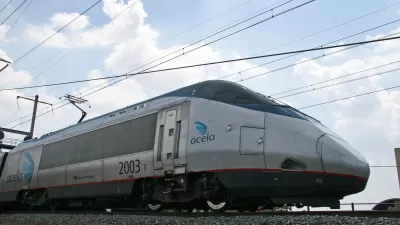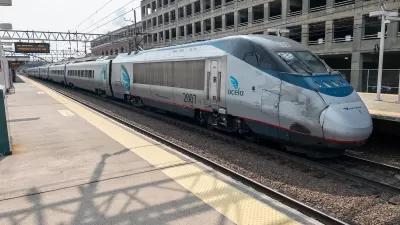This article from Next American City looks at rising ridership on Amtrak and how the train operator is not quite ready to handle it.
"Although Amtrak runs some trains on time, and with a degree of proficiency and professionalism, its deep-rooted, systemic problems continue to haunt the company: poor on-time performance, run-down equipment, unappealing stations and spotty on-board service. Veteran passengers and even train crews will share stories of broken toilets, dirty trains, diner cars without food and long delays due to freight traffic. Yet they also celebrate the comfort and romance of train travel on a good day - camaraderie among passengers, comfortable seating, pretty good food when it's available, sublime landscapes and freedom from driving."
"Despite its problems, Amtrak will carry about 28 million passengers in 2008, up from 25.8 million last year. Trains ran at 90 percent to full capacity. Ticket revenues exceeded last year's by 16 percent. It's no exaggeration then to say that Amtrak and America are on the verge of a rail renaissance, but this transformation won't happen overnight, warns Amtrak spokesman Cliff Black. 'The irony of this boom is that we are not prepared for a wholesale shift to passenger rail. The market is there, but we don't have the additional equipment and the excess capacity. We're running the wheels off some of these trains,' he admits. 'We need to make significant investments, and it's going to take some time.'"
Amtrak has run bare-bones for years, unable to purchase new passenger cars, cutting routes, and paying down debt. It owns only a small portion of track on its 22,000-mile network, so it cannot add trains and routes except by negotiating with the freight companies, who are experiencing their own boom in business."
FULL STORY: A New Era for Train Travel?

Manufactured Crisis: Losing the Nation’s Largest Source of Unsubsidized Affordable Housing
Manufactured housing communities have long been an affordable housing option for millions of people living in the U.S., but that affordability is disappearing rapidly. How did we get here?

Americans May Be Stuck — But Why?
Americans are moving a lot less than they once did, and that is a problem. While Yoni Applebaum, in his highly-publicized article Stuck, gets the reasons badly wrong, it's still important to ask: why are we moving so much less than before?

Research Shows More Roads = More Driving
A national study shows, once again, that increasing road supply induces additional vehicle travel, particularly over the long run.

Judge Halts Enforcement of Anti-Homeless Laws in Grants Pass
The Oregon city will be barred from enforcing two ordinances that prosecute unhoused residents until it increases capacity and accessibility at designated camping sites.

Advancing Sustainability in Los Angeles County Schools
The Los Angeles County Office of Education’s Green Schools Symposium brings together educators, students, and experts to advance sustainability in schools through innovative design, climate resilience strategies, and collaborative learning.

Using Old Oil and Gas Wells for Green Energy Storage
Penn State researchers have found that repurposing abandoned oil and gas wells for geothermal-assisted compressed-air energy storage can boost efficiency, reduce environmental risks, and support clean energy and job transitions.
Urban Design for Planners 1: Software Tools
This six-course series explores essential urban design concepts using open source software and equips planners with the tools they need to participate fully in the urban design process.
Planning for Universal Design
Learn the tools for implementing Universal Design in planning regulations.
City of Moreno Valley
Institute for Housing and Urban Development Studies (IHS)
City of Grandview
Harvard GSD Executive Education
NYU Wagner Graduate School of Public Service
City of Cambridge, Maryland
Newport County Development Council: Connect Greater Newport





























